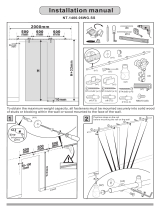
Customer Service: 800-945-2726
— 2 —
Installation Instructions
Remodeline (Sectional Units)
Aquatic products may be specified as Lasco Bathware.
n Tub - Mounted Fittings: Refer to dimensions noted above; mark fitting locations. Using a hole saw (fine tooth or abrasive grit cutting edge), make
necessary openings for filler and valves, drilling from inside (smooth side) out.
n Door Enclosures: Use AQUATIC shower door model for an engineered fit. Reference the Complete Works Catalog or the AQUATIC Bathware
website for the shower door installation guide.
NOTE: Where local codes specify minimum door openings, shower stalls may require swing (not sliding) doors.
CLEAN-UP
CAUTION: DO NOT USE heat, or solvent based cleaning fluids
NOTE: Do not remove adhered label. Warranty/User Maintenance Label must be left for occupant. (Required by ANSI Z124)
1. To prevent staining and/or blistering: Remove all construction debris before filling product for plumbing inspection. Drain and wipe clean
immediately after the inspection process. Use sponge with warm water and liquid detergent. Do not use abrasive cleaners, such as scouring powders
or pads, steel wool, scrapers, sandpapers or anything else that may scratch, mar or dull the finish. Roofing tar or paints may be removed with
turpentine, rubbing alcohol or paint thinner (not lacquer thinner).
2. Plaster may be removed by scraping with the edge of a piece of wood or rigid plastic. Do not use a metal scraper or utensil to remove plaster or
paint from finish.
3. Dulled areas can be restored to a high gloss with white or cream-colored automotive rubbing compound, followed by application of a coat of good
quality white automotive polish (or similar) and buff with a soft cloth.
4. Remove minor scratches with 600 grit wet/dry sandpaper, followed by Step #3 (above).
5. Major gouges require professional repair.
USER MAINTENANCE INSTRUCTIONS
IMPORTANT! Use only recommended cleaners and procedures described herein. Use of other materials and methods may damage your bath fix-
ture and void the warranty.
n For normal cleaning: Never use abrasive cleaners such as scouring powders or pads, steel wool, scrapers, sandpaper or anything else that could
scratch or dull the surface of your AQUATIC unit. Instead, use warm water and liquid detergents or non-abrasive cleansers, especially those bathroom
cleaners recommended for cleaning fiberglass.
n To keep your AQUATIC bath fixture sparkling clean: Apply a coat of good quality automotive paste wax or polish and buff to a high shine with
a soft cloth or towel. Repeat every six months for easier cleaning and long lasting protection.
NOTE: DO NOT WAX standing surfaces of the unit bottom (this includes textured, slip resistant standing surfaces), which could result in greater risk of
slipping and personal injury.
n To restore a scratched or dull unit: Use an automotive polishing compound applied with a clean cotton rag. Rub scratches and dull areas vigorously.
Wipe off residues. Follow with automotive wax treatment described above.
n To remove adhesive: Try 3-M Natural Cleaner, De-Solv-It or similar materials. If residues remain, saturate a small, white, cotton rag with nail polish
remover (naphtha or acetone) and rub vigorously until the adhesive dissolves and disappears. These solvents are highly flammable and must be used
sparingly and with caution. Do not smoke or permit others to do so. Make sure all nearby heating devices (including pilot lights) are extinguished.
Do not allow solvent to go down the drain. Make sure not to contact plastic drain grates or other synthetic materials.
n Rubber Mats: If you use a rubber “anti-skid” mat, make sure to remove it from the unit after each use to avoid harm to the surface finish.
n Hard Water: Water in certain regions, if not wiped up after bathing/showering, may cause fading of some bath fixture colors. This is a natural
occurrence beyond AQUATIC’s control. (See Warranty)
Silicone Application and Maintenance
NOTICE: Silicone maintenance and continual upkeep are the homeowner’s responsibility.
The wet, humid conditions in a bathroom, along with the use of cleansing products in tubs and shower stalls, can lead to silicone failure. AQUATIC recommends
inspecting silicone joints periodically and replacing bad silicone as necessary. Most silicone suppliers provide detailed caulking instructions; the guideline below
describes the techniques for using and maintaining silicone sealant applied to gelcoat and acrylic surfaces only.
n Apply 100% silicone sealant with mildew-resistant properties to the joint/seam. To ensure a proper seal, clean and prepare the surface area
immediately before applying the silicone. [See Diagram 3]
NOTE: When using solvents to clean surfaces and remove various contaminants, make sure to use a non-contaminated solvent and a clean towel or cloth.







